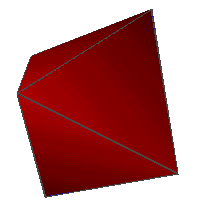Cutting an octahedron into two halves
| Find a plane through a point outside of an octahedron such that the plane bisects the volume of the octahedron. |
![]()

The formulation of the problem is somewhat misleading. For someone who does not work with polyhedra on a daily basis the word octahedron will probably emerge as the center of attraction, as the main piece of data that required most of one's attention. Octahedron is one of the five Platonic bodies. These are regular polyhedra, i.e. polyhedra such that at any vertex the same number of faces meet and, in addition, all faces are formed by equal regular polygons. Octahedron has 8 faces, 12 edges and 6 vertices. There is a special symmetry octahedral group named after this shape. In particular, octahedron possesses central symmetry. In other words, there exists a point O such that the octahedron is symmetric with respect to that point.
Well, of all the facts one may collect about octahedra, the only one with the bearing on our problem is that is has the central symmetry. Any body with this property will have its volume (and the surface area to boot) cut into two equal halves by any plane through the center of symmetry O. For a given point P outside the body there exists an infinity of planes passing through both P and A. Any such plane will solve our problem.
After a solution has been presented the problem seems almost trivial. However, it may have not been to start with. The simplest way I can think of to approach the problem is to consider first its plane analog - a shape consisting of two triangles attached base-to-base. I would draw several lines trying to detect in what positions they halve the shape's area. It could also be interesting to investigate whether or not the same line halves both the perimeter and the area of our shape.
![]()
The problem is still too simple to give up at this point. We generalized the problem by removing unnecessary specialization that the body under consideration must be an octahedron. Now the problem sounds the following way:
| (I) | Find a plane through a point outside a centrally symmetric body that bisects its volume. |
Is there anything else we can try to do away with? For a centrally symmetric body fixing a point through which a plane should pass does not constitute a restriction at all. Assuming that we have resolved to end up with a problem of bisecting a body's volume, the only descriptive thing that remains in the formulation is that the body possesses a center of symmetry. Can we give up this?
| (II) | Find a plane through a point outside a given 3d body that bisects its volume. |
This is a nice problem provided it has a solution. Perhaps it's simpler to start with a problem that does not have a point fixed?
| (III) | For a given 3d body, find a plane that bisects its volume. |
The answer to this is Not really, it's not very much of a simplification. Perhaps unexpectedly, these and some more complex problems have a solution based on the seemingly trivial Bolzano Theorem (BT).
|
Let, for two real a and b, a < b, a function f be continuous on a closed interval |
![]()
To apply BT we ought to designate a function continuous on a closed interval
We'll have to take its continuity for granted although intuitively the fact is simple. When t changes a little, the volume
between the two "successive" positions of the plane can be enclosed into a flat brick with the height equal to the
distance between the two positions. Thus it is bound to be small. Now,
![]()
Note that the direction of the plane may be chosen quite arbitrarily as may the manner of its motion. For example, we can fix a straight line and make the plane rotate around it. In case the line passes through a given point we get a solution to the problem (II).
Further, we can consider a group of several shapes and their cumulative volume. Or we could define a shape with holes in it or even hidden cavities. Now that you know that there is a method that will work it's a question to find a hard problem to be solved, right?
One more remark. BT applies as well and with the same ease to the problem of bisecting the surface area or the boundary length of plane curves.
![]()
But what if we wanted to get four equal pieces and not just two?
![]()
|Contact| |Front page| |Contents| |Generalizations| |Geometry|
Copyright © 1996-2018 Alexander Bogomolny
73598121
